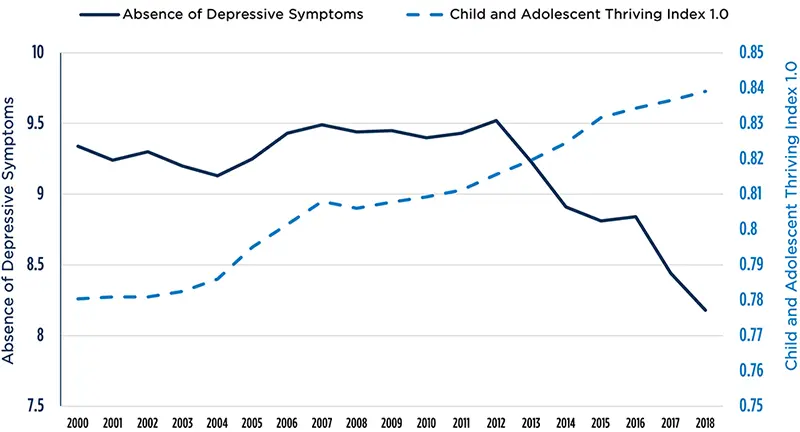
Child and Adolescent Mental Health Outcomes Are Declining Despite Continued Improvements in Well-being Indicators
Recent trends in child and adolescent mental health are dramatic and worrying to researchers, policymakers, and advocates. Although the COVID-19 pandemic brought a greater sense of urgency to the issue, the roots of this problem go back more than a decade, with worrying trends in depressive and anxiety symptoms—as well as suicide—beginning around 2010.
To directly address this issue, Congress and the Biden administration have proposed a broad set of policy responses. While most of these actions focus on expanding access to, and affordability of, mental health services, others have called for complementary policies that focus on improving a set of social indicators thought to correspond with improved mental health and well-being, such as raising high school graduation rates, decreasing adolescent substance use, and reducing food insecurity.
However, our recent research published in The Milbank Quarterly argues that policies that focus on improving these social indicators, while important, may not be as effective at addressing young peoples’ mental health as has been the case historically. This brief summarizes our findings, which show an apparent contradiction between the direction of social indicators and mental health outcomes. We posit that improved population-level monitoring of mental health—especially through better data collection—is a vital first step toward explaining the divergence between social indicators and mental health outcomes.
Findings
Our analysis in The Milbank Quarterly assesses available information on population-level mental health and well-being outcomes for young people in the United States and explores potential reasons why social indicators may be moving in the opposite direction. Here are some of our findings:
Child and adolescent mental health has declined even as social indicators of well-being improved.
Over the past decade, social indicators of well-being have continued to improve, even as indicators of depression, anxiety, and suicide have worsened. This pattern is most clearly illustrated by what researchers call “composite indices” of child and adolescent well-being, which summarize complex statistics on social indicators in a single number. While improvements in these measures are an important positive trend, it is concerning that direct measures of mental health outcomes have worsened over the same time span. Figure 1 below presents an overlay of one of these composite indices, the Child and Adolescent Thriving Index 1.0, with a summary measure of depressive symptoms taken from four questions fielded by the Monitoring the Future (MTF) Study (coded such that higher values correspond to a better outcome; see figure note for more information). A similar disjuncture is found when comparing an index based on the Annie E. Casey Foundation’s KIDS COUNT measures to other measures of mental health.
Figure 1: While indicators of child and adolescent thriving have improved, mental health has declined
Overlay of mental health measures and composite index scores

Notes
Analysis by race and ethnicity also shows a divergence between social indicators and mental health outcomes.
Historical and present racism—both interpersonal and systemic—impose greater stresses on youth of color and are associated with greater mental health strain. As such, policy responses that prioritize mental health equity should assess whether the pattern described above—wherein well-being indices and mental health outcomes have become uncoupled—remains when stratifying by race and ethnicity. Figure 2 below presents trends for the Child and Adolescent Thriving Index 1.0 against the depressive symptoms summary measure for Black, Latinx, and White young people separately. Although we wanted to also consider Asian and Indigenous young people, estimates were imprecise due to the smaller sample size in the MTF study.
Figure 2: Regardless of race/ethnicity, mental health has declined despite improved indicators of thriving
Mental health measures and composite index scores for Black, Latinx, and White children and adolescents

Notes
As with results for the overall population, we see mental health declines for Black, Latinx, and White youth alike. Additionally, there are some notable disparities across groups in terms of mental health, with Latinx adolescents reporting worse levels of depressive symptoms than both Black and White adolescents. Also paralleling the results seen for all youth, the social indicators measure improved for all three racial and ethnic groups—albeit with clear and persistent inequities for Black and Latinx young people, whose overall thriving scores were lower than those of their White peers.
Altogether, the trend of uncoupling seen among the overall population of youth—and among the three racial and ethnic groups we examined specifically—has worrying implications for policymakers. Specifically, current approaches that target the social indicators may not be especially effective in improving young peoples’ mental health, nor will they decrease disparities in mental health outcomes across races and ethnicities.
Discussion: Making Sense of Seemingly Contradictory Findings
There has been an unmistakable recent divergence between mental health outcomes and the social indicators of well-being that might be thought to predict them, a trend that is deeply consequential for policy. Furthermore, this divergence is happening to all children regardless of their race/ethnicity (not to mention across gender and socioeconomic status as well). For example, unlike the patterns among adolescents (ages 13 to 17) and young adults (ages 18 to 24), suicide rates among children ages 12 and under are consistently higher for Black children relative to White children. We believe there are several important lessons and next steps.
Researchers do not currently know why children’s mental health outcomes are diverging from social indicators of well-being. Since the initial emergence of the adverse trends in children’s mental health, researchers have proposed several theories for its underlying explanation. These include the widespread adoption of social media; long-term economic effects resulting from the Great Recession; worsening social contexts resulting from issues such as mass incarceration, widely publicized incidents of racial violence, school shootings, climate change, and the opioid epidemic; and lower resilience among children resulting from changes in parenting practices. However, the true underlying explanation (or the combination of several of these) remains unknown.
There are also several possible explanations for the unexpected similarities in mental health outcomes between White and Black young people. Given the interpersonal and systemic discrimination faced by Black youth in the United States, it is somewhat surprising to see them report symptoms of mental health that are similar to those of their White counterparts.
Researchers have proposed theories to explain this unexpected finding:
- Greater levels of non-economic assets within families and communities, such as deeper social and cultural capital, may help buffer Black youth from the adversities they face.
- Black youth may possess greater levels of resilience to counter these adversities (with an important caveat that any such resiliency should not be used as justification to not remediate these inequitable conditions).
- Cultural bias in measurement tools has meant that mental health challenges for Black youth are not being measured accurately.
These explanations have been subject to lengthy debate among scholars, and ultimately require more data and research to fully resolve. Furthermore, Black youth do experience worse mental health outcomes in some instances. Accordingly, policymakers must continue to pursue strategies to remediate inequities in the structural determinants of well-being as conceptualized by the current composite index measures. The status quo of expecting communities of color to develop coping strategies to mitigate the adversities they face is both unjust and ultimately perpetuates these inequities.
Researchers must bolster their efforts to collect data on young peoples’ mental health. The first, and most important, step toward explaining these contradictory and unexpected findings is to collect more data. Better data collection is long overdue and increasingly difficult to address in the current policy environment.
Nevertheless, our current understanding of young peoples’ mental health is severely restricted by several factors:
- A lack of state and local data
- Reduced ability to examine smaller racial/ethnic subpopulations such as Asian and Indigenous young people
- Very little information on more positive aspects of mental health that could provide a more comprehensive picture of how young people are faring
- Fragmentation across several data sources, which challenges researchers’ ability to link mental health to its broad set of social, economic, political, and commercial determinants
- An outdated set of social indicators that does not consider other important aspects of young peoples’ lives, such as social media usage, relationship quality with friends and family, and climate anxiety
Conclusion
Prioritizing young people’s mental health and well-being should be a central goal of health and social policy. The COVID-19 pandemic has spotlighted and exacerbated many of the longstanding issues affecting young people and their families. Child and adolescent mental health are likely even worse now than shown in the data presented here emphasizing the need to more fully understand young peoples’ mental health and well-being. By broadening and deepening the scope of the data that track mental health, policymakers will be able to design more effective solutions while also centering important issues like mental health equity. Ultimately, we believe that these efforts are a necessary component in support of an agenda that prioritizes the health and development of future generations.
Suggested citation
Anderson, N.W., Zimmerman, F.J., Markowitz, A.J., Halfon, N., Eisenberg, D., & Moore, K.A. (2023). Child and adolescent mental health outcomes are declining despite continued improvement in well-being indicators. Child Trends. https://doi.org/10.56417/3158p5450w
© Copyright 2024 ChildTrendsPrivacy Statement
Newsletter SignupLinkedInThreadsYouTube